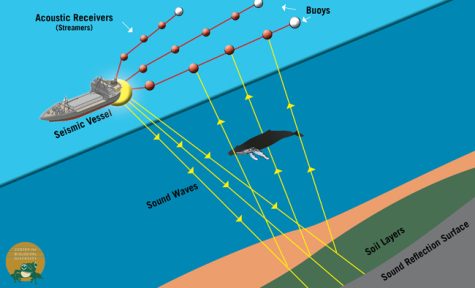Narwhals Need Some Peace and Quiet
In the remote waters of the Arctic lives a majestic, elusive whale, a whale so special that it needs its own article separate from “An Ode to Whales” (an article that I wrote! Linked here). If it is not already abundantly clear, I am a fan of whales, which is why the plight of the narwhals, a whale species native to the Arctic, has become an increasingly concerning issue in my eyes.
I believe that all of us reading this article can agree upon one fact: breathing is important, for both humans and narwhals. Narwhals swim underneath the ice, but every so often they search for gaps where they can swim up to the surface and breathe. Climate change, however, has led to unprecedented patterns of ice freezing and melting. Ice suddenly freezing leads to narwhal entrapment, when a group of whales is stuck in one breathing hole between ice sheets. Additionally, orcas (which actually aren’t whales!) have recently been choosing to extend their summer vacations in the Arctic, leaving more time for them to relax in the warming water and hunt narwhals. Scientists have known that climate change adversely affects narwhals in the Arctic. So what’s new?
Perhaps another fact upon which we can agree: food is essential to survival. Unlike us humans, narwhals hunt for food in deep parts of the ocean where light is unable to penetrate, and they rely on echolocation to communicate with their narwhal friends. However, ship sonars used to find and harvest oil stress out narwhals, preventing them from swimming to the depths of the ocean to hunt for food; as a result of oil exploration ships in the Arctic, narwhals are effectively starving. Recently, more ships have been traveling to the Arctic, increasing noise pollution.
The University of Copenhagen conducted a study in which they tagged six narwhals in order to observe their behavior when the whales encountered a ship’s engine and a seismic airgun, a device used to detect oil and natural gasses.

The research team caused a ruckus using their ship equipment every 80 seconds to attempt to elicit a reaction from the narwhals. The scientists conducting the study found that the narwhals were disturbed by noises that were 25 miles away from them or less, and stopped eating altogether when noises were five miles away. In order to attempt to get away from the boats, narwhals would swim away quickly along the surface of the water. This new published study was the first time that scientists were able to confirm the harm that noise pollution causes for narwhals.
Hopefully, now we can all agree that narwhals need some peace and quiet. Imagine if someone were blasting a fire alarm while you were just peacefully trying to eat breakfast!
Sources:
Holloway, Marguerite. “In an Increasingly Noisy Arctic, Will Narwhals Fall Silent?” The New Yorker, 31 Aug. 2021, www.newyorker.com/science/elements/the-acoustic-lives-of-narwhals. Accessed 8 Feb. 2022.
O’Connell-Domenech, Alejandra. “New study finds narwhals ‘highly affected’ by noise from ships.” The Hill, 18 Dec. 2021, thehill.com/changing-america/sustainability/environment/586364-new-study-finds-narwhals-highly-affected-by-noise. Accessed 8 Feb. 2022.
Rosane, Olivia. “Noise Pollution Is Coming for the Narwhals.” Treehugger, 3 Jan. 2022, www.treehugger.com/noise-pollution-is-coming-for-narwhals-5214146. Accessed 8 Feb. 2022.
“Seismic Blasting.” Center for Biological Diversity, www.biologicaldiversity.org/campaigns/seismic_blasting/. Accessed 8 Feb. 2022.
Vandermeer, Emily. “Why Narwhal Are the Most Vulnerable to a Warmer, Louder Arctic.” World Wildlife Fund, 16 Feb. 2021, wwf.ca/stories/why-narwhal-are-the-most-vulnerable-to-a-warmer-louder-arctic/. Accessed 8 Feb. 2022.









